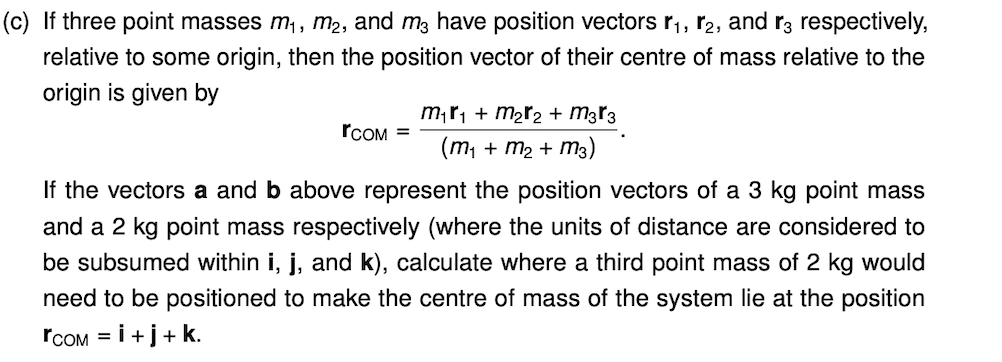If three point masses m, m2, and m3 have position vectors r,, r2, and r3 respectively, relative to some origin, then the position vector of their centre of mass relative to the origin is given by m¡r, + m2r2 + m3r3 rCOM = (m, + m2 + m3) If the vectors a and b above represent the position vectors of a 3 kg point mass and a 2 kg point mass respectively (where the units of distance are considered to be subsumed within i, j, and k), calculate where a third point mass of 2 kg would need to be positioned to make the centre of mass of the system lie at the position
If three point masses m, m2, and m3 have position vectors r,, r2, and r3 respectively, relative to some origin, then the position vector of their centre of mass relative to the origin is given by m¡r, + m2r2 + m3r3 rCOM = (m, + m2 + m3) If the vectors a and b above represent the position vectors of a 3 kg point mass and a 2 kg point mass respectively (where the units of distance are considered to be subsumed within i, j, and k), calculate where a third point mass of 2 kg would need to be positioned to make the centre of mass of the system lie at the position
University Physics Volume 1
18th Edition
ISBN:9781938168277
Author:William Moebs, Samuel J. Ling, Jeff Sanny
Publisher:William Moebs, Samuel J. Ling, Jeff Sanny
Chapter9: Linear Momentum And Collisions
Section: Chapter Questions
Problem 103AP: Three skydivers are plummeting earthward. They are initially holding onto each other, but then push...
Related questions
Topic Video
Question

Transcribed Image Text:(c) If three point masses m, m2, and m3 have position vectors r,, r2, and r3 respectively,
relative to some origin, then the position vector of their centre of mass relative to the
origin is given by
m;r, + m2r2 + m3r3
(m, + m2 + m3)
rCOM =
If the vectors a and b above represent the position vectors of a 3 kg point mass
and a 2 kg point mass respectively (where the units of distance are considered to
be subsumed within i, j, and k), calculate where a third point mass of 2 kg would
need to be positioned to make the centre of mass of the system lie at the position
rCOM = i+j+ k.
Expert Solution
This question has been solved!
Explore an expertly crafted, step-by-step solution for a thorough understanding of key concepts.
This is a popular solution!
Trending now
This is a popular solution!
Step by step
Solved in 2 steps with 2 images

Knowledge Booster
Learn more about
Need a deep-dive on the concept behind this application? Look no further. Learn more about this topic, physics and related others by exploring similar questions and additional content below.Recommended textbooks for you

University Physics Volume 1
Physics
ISBN:
9781938168277
Author:
William Moebs, Samuel J. Ling, Jeff Sanny
Publisher:
OpenStax - Rice University

Classical Dynamics of Particles and Systems
Physics
ISBN:
9780534408961
Author:
Stephen T. Thornton, Jerry B. Marion
Publisher:
Cengage Learning

University Physics Volume 1
Physics
ISBN:
9781938168277
Author:
William Moebs, Samuel J. Ling, Jeff Sanny
Publisher:
OpenStax - Rice University

Classical Dynamics of Particles and Systems
Physics
ISBN:
9780534408961
Author:
Stephen T. Thornton, Jerry B. Marion
Publisher:
Cengage Learning